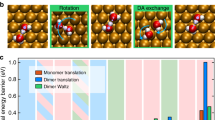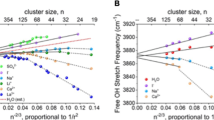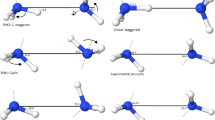Abstract
IN molecular liquids that may form dimers, for example by hydrogen-bonding, direct evaporation of dimers is possible when these form stable molecules. A gradual change from monomer to dimer evaporation would be expected at pairwise molecular bond energies of intermediate strength—that is, ~ 0.01–1 eV, a range of values that is typical of hydrogen-bond strengths in liquids. Here we use molecular-beam techniques to study the evaporation of large fractions of acetic and formic acid dimers from the pure liquids and from solutions. We find that their velocity distributions are non-maxwellian, and that the average dimer energies exceed the temperature of the liquid surface by 100–200 K. These unexpected effects may be qualitatively explained by a crude model in which surface-tension forces act upon non-wetting, twin-hydrogen-bond dimer inclusions within an extended, monomeric hydrogen-bonded 'sheet' at the liquid surface.
This is a preview of subscription content, access via your institution
Access options
Subscribe to this journal
Receive 51 print issues and online access
$199.00 per year
only $3.90 per issue
Buy this article
- Purchase on Springer Link
- Instant access to full article PDF
Prices may be subject to local taxes which are calculated during checkout
Similar content being viewed by others
References
Knudsen, M. Ann. Phys. 28, 75–130 (1909).
Anderson, J. B. in Molecular Beams and Low Density Gas Dynamics (ed. Wegener, P. P.) (Dekker, New York, 1974).
Faubel, M., Schlemmer, S. & Toennies, J. P. Z. Phys. D10, 269–277 (1988).
Reimer, J. R. & Watts, R. O. Chem. Phys. 85, 83–112 (1984).
Vernon, M. F. et al J. chem. Phys. 77, 47–57 (1982).
Dyke, T. R., Mack, K. M. & Muenter, J. S. J. chem. Phys. 66, 498–510 (1977).
Chao, J. & Zwolinski, B. J. J. phys. Chem. Ref. Data 7, 363–377 (1978).
Bertagnolli, H. Chem. Phys. Lett. 93, 287–292 (1982).
Sievert, R., Cadez, I., van Doren, J. & Castleman, A. W. J. phys. Chem. 88, 4503–4505 (1984).
Mori, Y., Kitagawa, T., Yamamoto, T., Yamada, K. & Nagahara, S. Bull. chem. Soc. Jap. 53, 3492–3495 (1980).
Mori, Y. & Kitagawa, T. in Atomic Collision Research in Japan 13, 138–141 (Society for Atomic Collision Research, Riken, Saitama 351–01, 1987).
Boltzmann, L. Wien. Ber. 63, 397–420 (1871).
Richardson, O. W. Phil. Mag. 28, 633–647 (1914).
Comsa, G., David, R. & Rendulic, D. Phys. Rev. Lett. 38, 775–778 (1977).
Comsa, G. & David, R. Surf. Sci. Rep. 5, 145–198 (1985).
CRC Handbook of Chemistry and Physics (ed West R C ) (CRC Press Inc., Florida. 1977).
Author information
Authors and Affiliations
Rights and permissions
About this article
Cite this article
Faubel, M., Kisters, T. Non-equilibrium molecular evaporation of carboxylic acid dimers. Nature 339, 527–529 (1989). https://doi.org/10.1038/339527a0
Received:
Accepted:
Issue Date:
DOI: https://doi.org/10.1038/339527a0
This article is cited by
-
Generalized Entropy Approach for Conserved Systems with Finite Entities: Insights into Non-Gaussian and Non-Chi-Square Distributions using Havrda-Charvát-Tsallis Entropy
International Journal of Theoretical Physics (2023)
-
Gas-phase pyrolysis of methyl glucosides and levoglucosan
Journal of Wood Science (2017)
-
Binding energies, lifetimes and implications of bulk and interface solvated electrons in water
Nature Chemistry (2010)
-
Ultrafast electronic spectroscopy for chemical analysis near liquid water interfaces: concepts and applications
Applied Physics A (2009)
-
Droplet streams for serial crystallography of proteins
Experiments in Fluids (2008)
Comments
By submitting a comment you agree to abide by our Terms and Community Guidelines. If you find something abusive or that does not comply with our terms or guidelines please flag it as inappropriate.



